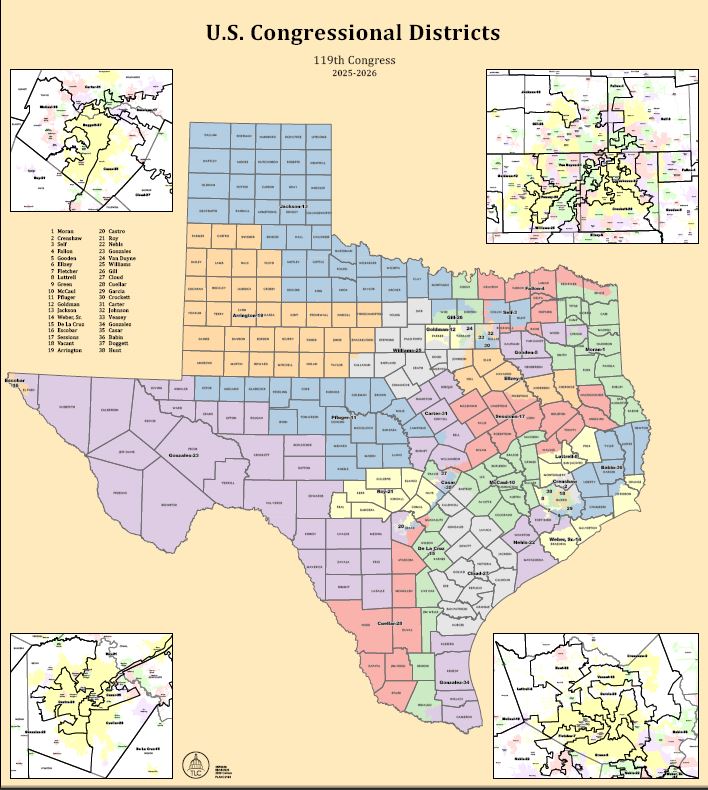
July 22, 2025

Redistricting is one of the most important and partisan tasks legislators undertake every ten years, occurring after the completion of the federal census. With the last census in 2020, I had the privilege of serving as Vice Chair of the Senate Redistricting Committee in 2021, when we passed the current maps for congressional and state districts. The maps were designed to remain in effect for a decade until the next census in 2030. It is important to note that in 2021, Republicans controlled both the Texas House and Senate, as they do today. But now, under the current federal administration, we face partisan pressure to redraw our congressional districts.
Earlier this month, the U.S. Department of Justice sent a letter to Governor Greg Abbott and Attorney General Ken Paxton informing them that three districts in Houston and one in Fort Worth are deemed “unconstitutional ‘coalition districts’” due to their composition. Coalition districts are primarily made up of minority voters who often vote together.
During a federal lawsuit challenging the current maps, Republican leadership argued that the maps were drawn “race blind.” However, when Governor Abbott called for a special legislative session starting July 21 to redraw the maps again, in his proclamation he referenced the DOJ letter and stated that race had been improperly considered in shaping at least four majority-minority districts held by Democrats. Ironically, Governor Abbott approved this map when he signed Senate Bill 6 into law in 2021, the very legislation he now suggests is unconstitutional.
I voted against SB 6 because I believed the map undermined minority voting strength and lacked competitiveness. I proposed an amendment to SB 6 with the purpose of making Congressional Districts 15 and 34 more competitive, allowing candidates to campaign and persuade voters as to why they should be the Congress person representing them in the Rio Grande Valley.
At the time, my amendment was based on the vote percentages from the 2020 presidential election results with Congressional District 15, based out of Hidalgo County, being drawn with Democrats at 50.8% and Republicans at 48.2%. For Congressional District 34, based out of Cameron County, I proposed Democrats at 51.8% and Republicans at 47.1%, making both congressional districts extremely competitive. Unfortunately, Republicans opposed my amendment, citing potential negative impacts on political dynamics and increased litigation risks. As a result, the amendment failed along partisan lines with a 13-18 vote.
This is not the first time Republicans have modified maps in the middle of the decade to change the rules before an election. In 2003, when Democrats held a majority of congressional seats despite Republicans controlling the Legislature, then-U.S. House GOP Leader Tom DeLay pressured state lawmakers to abandon the maps drawn in 2001 and create new ones designed to help President George W. Bush and secure a Republican majority in Congress. However, this time, the situation is even more alarming. Republicans are redrawing maps created by fellow Republicans under direct pressure from the President of the United States, who aims to retain Republican control in Congress following the 2026 elections. This move is a clear expression of a raw political power grab.
The Trump administration is leveraging their influence to push for maps that serve their interest in the short term. They are using the DOJ to question minority “coalition districts” when according to the Texas Demographic Center, white residents comprise less than 40% of the Texas population, yet attempts are being made to draw a map that would allow white voters to dictate 28 to 30 of Texas's 38 congressional seats. This maneuver not only risks further marginalizing minority voters but will also set the stage for lengthy and costly litigation that will burden Texas taxpayers for years to come.
Just like we did four years ago, it is important for the public to stay informed and engage in the redistricting process. Participation in the upcoming hearings is very important. We must voice our regional issues and concerns to the redistricting committees in the House and the Senate. The Senate Committee on Redistricting will begin public hearings on July 25, and, like in 2021, these hearings will be held virtually to allow public testimony via Zoom videoconference. The House Redistricting Committee will begin hearings on July 24 in Austin.
Engaging in these hearings or submitting written testimony is an opportunity for voters to express their views on the congressional maps. Each of us is impacted by the decisions made during this special session. We must speak up to ensure our voices are heard. Voters should elect their representatives, not representatives cherry-picking their voters.
July 25, 2025 - 10am https://bit.ly/457XpuG
Regional focus: South and Central Texas including Bexar County, Travis County and the Rio Grande Valley regions
July 26, 2025 - 10am https://bit.ly/4mbxlFU
Regional focus: North Texas including the Dallas-Fort Worth region
July 28, 2025 - 3pm https://bit.ly/4o2pR9Q
Regional focus: East Texas including the Harris County region
July 29, 2025 - 9am https://bit.ly/40YGtoY
Regional focus: West Texas including the Panhandle and El Paso regions
Live streaming of the regional hearings is available here: https://senate.texas.gov/events.php
To submit written comments and attachments via the public-input portal, please visit the committee's website at https://senate.texas.gov/redistrictingcomment/
Within a few days after conclusion of the regional hearing, a video archive of the hearing will be available at the following link: https://senate.texas.gov/cmte.php?c=660#video
*All testimony is welcome at any hearing, regardless of the regional focus. Pursuant to Senate Resolution 5 (89th (1)), public testimony at these regional hearings will be by Zoom videoconference only. Details on how to register to testify appear in the publicly posted notice of each of these regional hearings.
QUICK LINKS
Who Represents Me?:
https://wrm.capitol.texas.gov/
View Proposed Redistricting Maps:
https://dvr.capitol.texas.gov/
View Redistricting Data:
https://data.capitol.texas.gov/
Learn More About Redistricting:
https://redistricting.capitol.texas.gov/
###